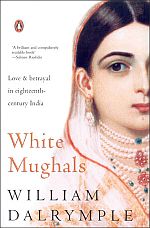An Excerpt from William Dalrymple’s “White Mughals”
It was middle of Muharram, the Shia’s festival commemorating the martyrdom of Hussain, the grandson of the Prophet. I had just finished a book on the monasteries of the Middle East, four years’ work, and was burnt out. I came to Hyderabad to get away from my desk and my overflowing bookshelves, to relax, to go off on a whim, to travel aimlessly again.
It was spring. The stones of the mosques were warm underfoot, and I wandered through the shrines of the old city, filled now with black-robed Muharram mourners reciting sinuous Urdu laments for the tragedy of Kerbala. It was as if Hussain had been killed a week earlier, not in the late seventh century AD. This was the sort of Indian city I loved.
It was, moreover, a relatively unexplored and unwritten place, at least in English; and a secretive one too. Unlike the immediate, monumental splendour of Agra or the Rajput city states of the north, Hyderabad hid its charms from the eyes of outsiders, veiling its splendours from curious eyes behind nondescript walls and labyrinthine backstreets. Only slowly did it allow you in to an enclosed world where water still dripped from fountains, flowers bent in the breeze, and peacocks called from the overladen mango trees. There, hidden from the streets, was a world of timelessness and calm, a last bastion of gently fading Indo-Islamic civilization where, as one art historians has put it, old ‘Hyderabadi gentlemen still wore the fez, dreamt about the rose and the nightingale, and mourned the loss of Grenada’.
From the old city, I drove out to see the craggy citadel of Golconda. For six hundred years Golconda was the storehouse of the apparently ceaseless stream of diamonds that emerged from the mines of the region the only known source of these most precious of stones until the discovery of the New World mines in the eighteenth century. Inside the wall you passed a succession of harems and bathing pools, pavilions and pleasure gardens. When the French jeweler Jean Baptiste Travenier visited Golconda in 1642 he found a society every bit as wealthy and effete as this architecture might suggest. He wrote that the town possessed more than twenty thousand registered courtesans, who took it in turns to dance for the Sultan every Friday.
This richly romantic and courtly atmosphere had, I soon discovered, infected even the sober British when they arrived in Hyderabad at the end of the eighteenth century. The old British Residency, now the Osmania University College for Women, was a vast Palladian villa, in plan not unlike its exact contemporary, the White House in Washington. It was one of the most prefect buildings ever erected by the East India Company, and lay in a massive fortified garden just over the River Musi from the old city.
The complex, I was told, was built by Lieutenant Colonel James Achilles Kirkpatrick, the British Resident – effectively Ambassador – at the court of Hyderabad between 1797 and 1805. Kirkpatrick had apparently adopted Hyderabad clothes and Hyderabadi ways of living . Shortly after arriving in the town, so the story went, he fell in love with the great-niece of the diwan (Prime Minister) of Hyderabad. He married Khair un-Nissa – which means ‘Most Excellent Among Women’ – in 1800, according to Muslim law.
Inside the old Residency building, I found plaster falling in chunks the size of palanquins from the ceiling of the former ballroom and durbar hall. Upstairs the old bedrooms were badly decayed. They were now empty and deserted, frequented only by bats and the occasional pair of amorous pigeons, downstairs the elegant oval saloons were partitioned by hardboard divides into tatty cubicles for the college administrators. As the central block of the house was deemed too dangerous for the students, most of the classes now took place in the old elephant stables at the back.
Even in this state of semi-ruination it was easy to see how magnificent the Residency had once been. It had a grand, domed semi-circular bay on the sought front, reached through a great triumphal arch facing the bridge over the Musi. On the north front a pair of British lions lay, paws extended, below a huge pedimented and colonnaded front. They looked out over a wide expanse eucalyptus, mulsarry and casuarina trees, every inch the East India Company at its grandest and most formal. Yet surprises lurked in the undergrowth at the rear of the compound.





